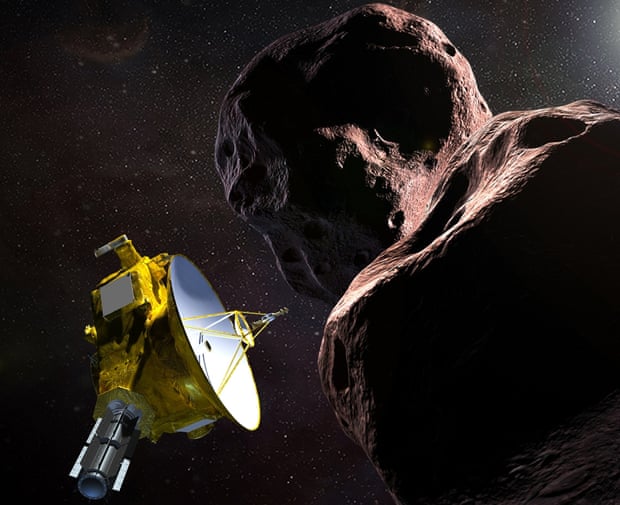It’s red, it’s cold, it’s 4bn years old: NASA data from Arrokoth reveals ‘profound truths’ about the solar system.
–
NASA has unveiled details of the most distant object visited by a spacecraft, in observations that could resolve a decades-long puzzle of how the planets first emerged from the hazy dust of the early solar system.
The ultra-red, peanut-shaped object, called Arrokoth, sits located 1bn miles beyond Pluto in the Kuiper belt, a vast donut-shaped region that is home to thousands of dwarf planets and icy objects. NASA’s New Horizons spacecraft made a flyby on New Year’s Day 2019, but the extreme distance from Earth means the probe is still beaming back data gathered during the brief encounter.
Prof Bill McKinnon, a planetary scientist at Washington University in St Louis, who is lead author of the latest work, said the findings made at Arrokoth are so significant that the New Horizons team had been left debating whether they would ultimately be viewed as more important than the probe’s first encounter with Pluto in 2015.
“Arrokoth has turned out to be astonishing in terms of what we’ve learned from it,” he said before a presentation at the annual meeting of the American Association for the Advancement of Science (AAAS) this week. “It tells us some profound truths about our solar system. This is not just a space potato. It’s a remarkable world that’s told us a remarkable story.”
Arrokoth’s position in the Kuiper belt marks what was once the fringes of the cloud of dust and gas, known as the solar nebula, that surrounded the newly formed sun. In this region, planetary development was arrested at an early stage because of the lower density of material available. Exploring these frozen wastelands allows scientists to peer back in time to an epoch when the seeds of today’s planets were being sown.
“This place is very far from the sun – so far that the temperatures are nearly at absolute zero,” said Dr Alan Stern, New Horizons’ principal investigator. “That preserves objects in a kind of stasis or time capsule.”
For decades, scientists have wrestled with two competing scenarios for how planetary formation kicked off. In the first, known as hierarchical accretion, small grains and pebbles zipped around occasionally bashing into each other with enough force to stick, making bigger and bigger objects. Gradually, over millions of years, planets accumulated matter though random, forceful collisions.
–
Under a second scenario, known as cloud collapse, certain regions of the nebula had a higher density of particles and these clumps were drawn towards each other, until they spontaneously gravitationally collapsed. Collisions were gentle and the planets were “born big”, with objects tens or hundreds of miles in diameter emerging within hundreds of years.
Arrokoth’s appearance and composition provide compelling evidence in support of the cloud collapse theory. “The imagery shows no signs of violence, no fractures, the two lobes don’t looks smashed together,” said Stern, who is based at Southwest Research Institute in Boulder, Colorado.
Everything about Arrokoth, he said, points towards a gentle coalescence. The object’s two lobes are also uniform in color and composition, both having ultra-red surfaces containing organic compounds, which implies the fragments were orbiting nearby each other, rather than coming from disparate parts of the nebula. The findings, along with other details of Arrokoth’s appearance and composition, appear in three papers in the journal Science.
Prof Andrew Coates, head of planetary science at the Mullard Space Science Laboratory, University College London, said: “These results show clear evidence that Arrokoth’s two lobes came together very gently and stuck, at just a brisk human’s walking pace on Earth, rather than in a high speed collision.
“Although there is evidence for faster collisions in the inner solar system later, such as when the moon formed from a large object hitting Earth, this work shows that much slower, more dignified interactions were important and common in the earliest history of the solar system.”
New Horizons was launched in 2006 and conducted a six-month flyby study of Pluto and its moons in 2015, before firing its engines to swing its trajectory towards Arrokoth (at that time known as Ultima Thule).
This summer, the team will conduct a survey with ground-based telescopes to see whether there are any objects in the Kuiper belt within reach of the probe’s limited fuel supplies. McKinnon described this as a “Hail Mary effort” for the mission, adding: “The chances aren’t large but they aren’t zero.”
Either way, New Horizons will continue to sail through the Kuiper belt and beyond, with its steadily decaying plutonium fuel expected to keep communication open until the 2030s. “At some point, no matter what we do, the fuel lines will freeze and then it can’t point itself to the Earth,” said McKinnon. “It won’t be able to talk to Earth and we won’t be able to talk to it, although it will be able to talk to itself probably for quite some time.”
–
(For the source of this, and many other equally intriguing articles, please visit: https://www.theguardian.com/science/2020/feb/13/not-just-a-space-potato-nasa-unveils-astonishing-details-of-most-distant-object-ever-visited-arrokoth/)









